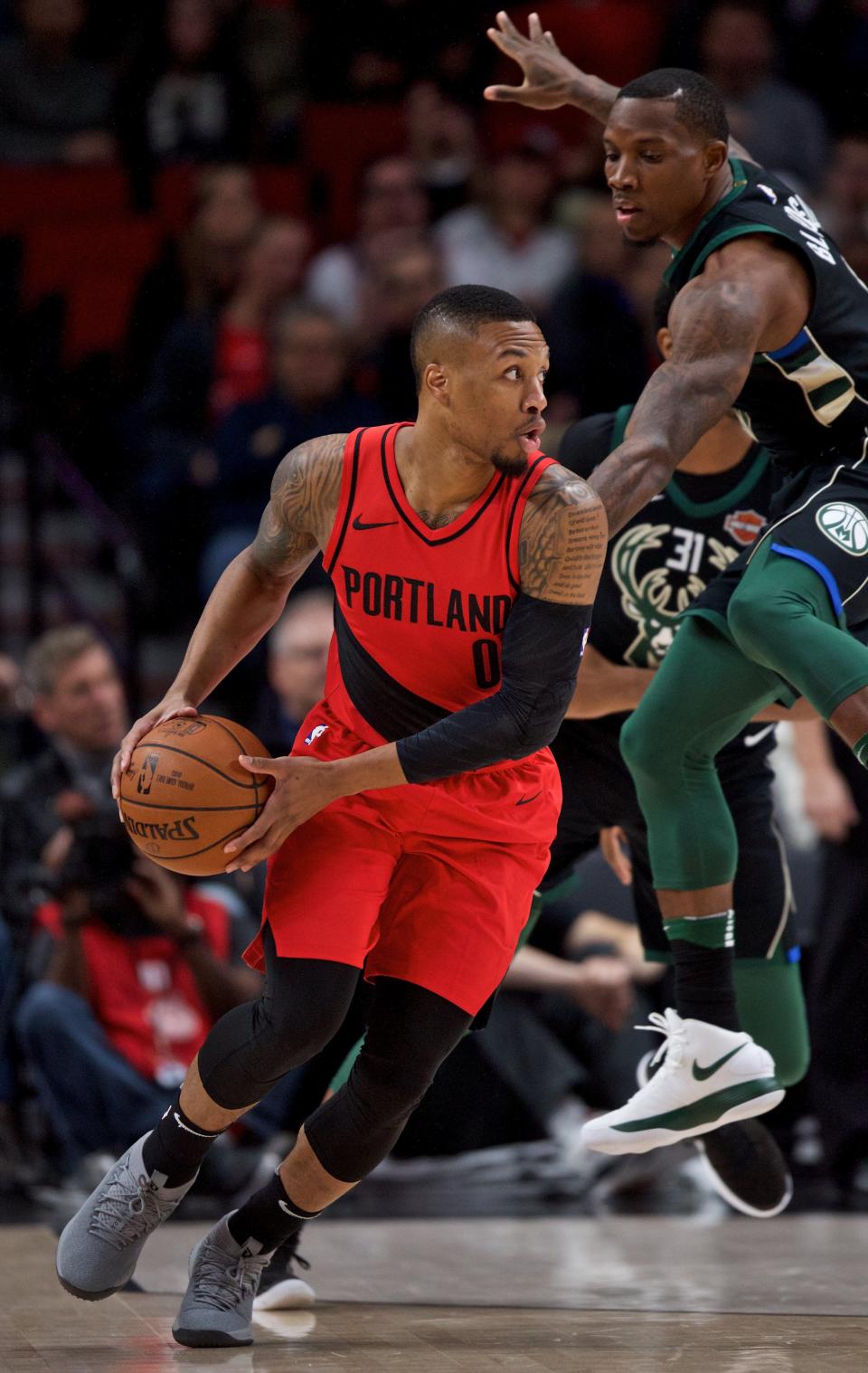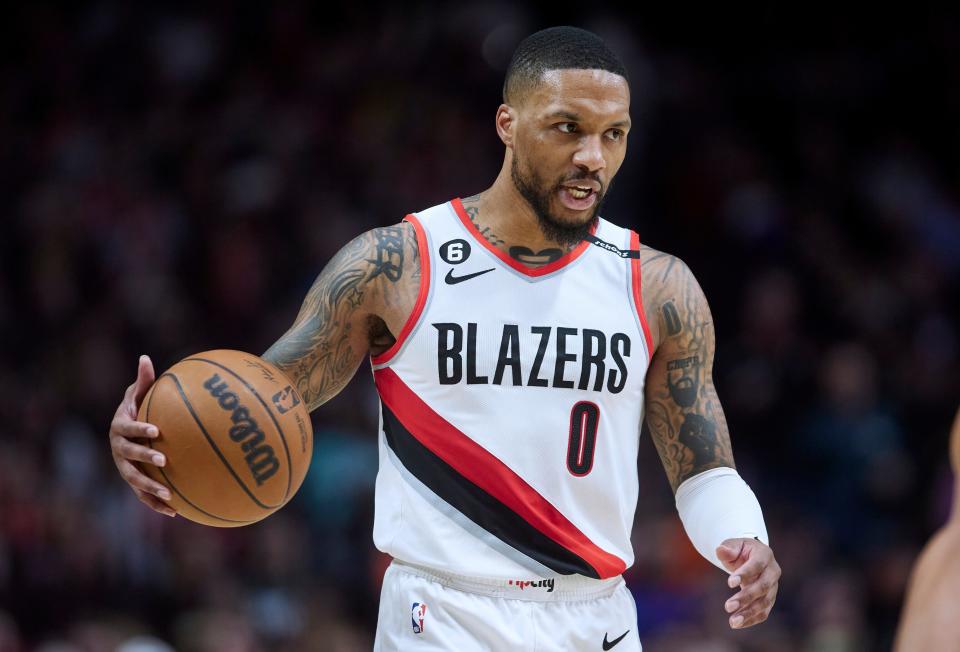The trade for Damian Lillard is an echo of past championship moves for the Milwaukee Bucks
Fifty years after the Milwaukee Bucks traded for a 10-time all-NBA and all-star point guard to team with their multi-time MVP big man, the organization seemingly replicated the move by acquiring Jrue Holiday to match with Giannis Antetokounmpo en route to capturing the team’s second championship.
On Wednesday, the Bucks remixed that formula in hopes of a similar result by trading Holiday and Grayson Allen, and swapping three-first round picks to acquire seven-time all-NBA and all-star point guard Damian Lillard from the Portland Trail Blazers.
For as superb as Holiday was pairing with Antetokounmpo and Khris Middleton, Lillard's acquisition is more akin to the trade for Oscar Robertson in the summer of 1970 that helped Kareem Abdul-Jabbar and the Bucks over the top for their first title that season.
How that all comes together will remain to be seen – but the Bucks were smart to make the move now, so Lillard and the team has an entire training camp and season to work together.
The first two times the Bucks have made such a massive move with a point guard worked out beautifully – no doubt they believe the third time will also be charmed.

How the Damian Lillard trade affects the Bucks on the court
Like Antetokounmpo, Lillard is an active all-time great, a member of the 75th anniversary team and future first-ballot Hall of Famer. The 33-year-old guard has been one of the league’s most-prolific offensive playmakers over the past eight years, averaging 27.5 points and 7.0 assists. He’s averaged 30 or more points per game twice.
Lillard’s penchant for late-game offensive heroics is an element the Bucks have lacked when Middleton isn’t available, an intangible steeliness that has translated to more than a dozen game-winning shots in his career. And, while the Trail Blazers advanced as far as the Western Conference finals only once in his decade in Portland, Lillard has averaged 25.7 points and 6.2 assists in 61 playoff games.
The Bucks now have two proven, cold-blooded shooters in Lillard and Middleton when it matters most in slowed-down, playoff crunch-time moments. And Lillard’s range will create space for Antetokounmpo even in condensed postseason half-court sets.
Milwaukee has, predictably, bogged down too often offensively with Middleton and Antetokounmpo injured the past two playoffs, so adding another force of nature to that duo in Lillard will no doubt help should bad injury luck once again plague the team.
And if all three (along with Brook Lopez and the supporting group) remain healthy? Look out.
Lillard (18.6 career shots per game) and Antetokounmpo (18.2 since becoming an all-star) may have to figure out who is taking fewer shots – but they genuinely like one another and at the stages of their respective careers, sharing the ball shouldn’t be a problem.
Using Antetokounmpo in the pick-and-roll with Lillard could be a near unstoppable two-man game. And this in addition to an already formidable Middleton-Antetokounmpo pairing, along with the two-man actions Antetokounmpo and Lopez were so effective with at times.
Shooters like Malik Beasley, Pat Connaughton and AJ Green should see more space. Lopez and Bobby Portis are now more dangerous pick-and-pop options with Lillard.
The respect the 33-year-old point guard engenders from defenders is just something the Bucks have not had even when Middleton is playing at an all-star level.
The team will most definitely take a step back defensively, as Holiday is an annual defensive player of the year candidate with the ability to guard nearly anyone one-on-one. Lillard isn’t that kind of player.
But new Bucks head coach Adrian Griffin already had planned to use a defensive scheme where help would be required and, with Antetokounmpo and Lopez serving as two of the premier rim protectors in the league, no doubt the Bucks believe the offensive upgrades will far outweigh any defensive drop off.
How the Damian Lillard trade affects the Bucks roster
There are, of course, other elements to consider with such a massive trade. As for the principals in the deal, Lillard in for Holiday is a one-for-one swap of starting all-star point guards.
But the Bucks backcourt was entirely remade, as they sent shooting-guard Allen to the Phoenix Suns. In his two seasons in Milwaukee, Allen started 131 of the 136 games he played while making 40.4% of his three-pointers.
Candidates to fill that off-guard spot are newly acquired guard Malik Beasley, who has mostly come off the bench in his seven-year career, and forwards Pat Connaughton and MarJon Beauchamp. Perhaps there are some lineups where Middleton acts as shooting guard, also. It seems unlikely that second-year guard Green or rookie Andre Jackson Jr. will get starting looks when the full complement of regulars are available.
By moving on from two rostered players, though, the Bucks now have 14 guaranteed contracts, which opens the door for another move.
The team still doesn’t have a backup point guard on a guaranteed deal, so there is now an option for the Bucks to add a more veteran option on the bench at that position. It is perhaps more important now for them to examine the free-agent market, as Holiday (193 games) has been a more durable player than Lillard (154) the past three seasons.

Bucks future drafts impacted
The team experienced a bit of a youth movement this offseason in drafting 21-year-old Jackson Jr. and Chris Livingston (who will be 20 on Oct. 15). They also signed 21-year-old guard TyTy Washington Jr., a 2022 first-round pick of the Memphis Grizzlies on a two-way deal. Coupled with their own first-round pick from a year ago in Beauchamp and the signing of Green (24) to a guaranteed deal, the back end of the Bucks roster got significantly younger.
But, the Bucks now do not control their own first-round pick until 2031.
They are still paying off the trade for Holiday to New Orleans, with the Pelicans controlling a swap in 2024, a top-4 pick in 2025, a swap in 2026 and the outright 2027 first-round pick. (New York now owns the Bucks’ pick if it falls between Nos. 5-30 in 2025).
Portland now owns the right to swap in 2028 and 2030 and owns Milwaukee’s outright 2029 first-round pick.
And, presuming Lillard (and the $170 million left on his contract through 2027) remains in Milwaukee and Antetokounmpo signs another “supermax” extension worth about $186 million next summer, the Bucks are likely to remain in the newly created second “tax apron” between 2025-29 which could make their 2032 first-round pick untradeable – and automatically dropped to No. 30 regardless of their record.
As for second-round picks, the Bucks are also severely depleted there. Due to the Jae Crowder trade last deadline, the Bucks own only their 2027 second-round selection.
Trade deadline options are squeezed
Since becoming the general manager in 2017, Jon Horst never has been shy about adding players during the season. The most impactful move was the acquisition of forward P.J. Tucker during the 2020-21 season, as Tucker became a key player in the Bucks’ run to a title.
As it currently stands, however, the Bucks don’t have draft picks to trade.
So during the season, should they be looking to adjust the roster, they will have be moving either veterans or the few young players on the team. And, when salary-matching is required, only Portis ($11.7 million) and Connaughton ($9.4) have deals that could net a higher-priced player – but they are two very important rotational players for the Bucks.
Middleton and Lopez are not eligible to be traded until mid-December, but even if injuries plague the team early in the season, it's unlikely this team would be breaking up its core in that fashion.
Is the championship window extended?
Not yet.
The team didn’t get any younger, as Lillard and Holiday are the same age. And it still seems unlikely Antetokounmpo will sign an extension by Oct. 23 because it makes little financial sense to do so – he can make about $70 million more by signing next summer.
Even if this move changes his mind on that, until Antetokounmpo signs an extension, the window remains this year and next based on the aligned contract lengths of Antetokounmpo, Middleton, Lopez, Portis and Connaughton.
But one must believe Antetokounmpo played a major role in giving his blessing to this trade, and it was no doubt done with an eye toward keeping him and Lillard (whose deal runs through a 2026-27 player option) together for more than just a season or two.
No one can say the Bucks haven’t shaken things up in the hopes of reaching the NBA Finals. Hiring a new head coach and adding a Top 75, future first-ballot Hall of Famer to a team that was the league’s top-seed a year ago are monumental changes.
They’re moves made not by a desperate team, but a heavyweight, and Milwaukee has once again squared up as one of the biggest contenders for a title in the NBA.
THANK YOU: Subscribers' support makes this work possible. Help us share the knowledge by buying a gift subscription.
DOWNLOAD THE APP: Get the latest news, sports and more
This article originally appeared on Milwaukee Journal Sentinel: Trading for Damian Lillard echoes past championship moves for Bucks
